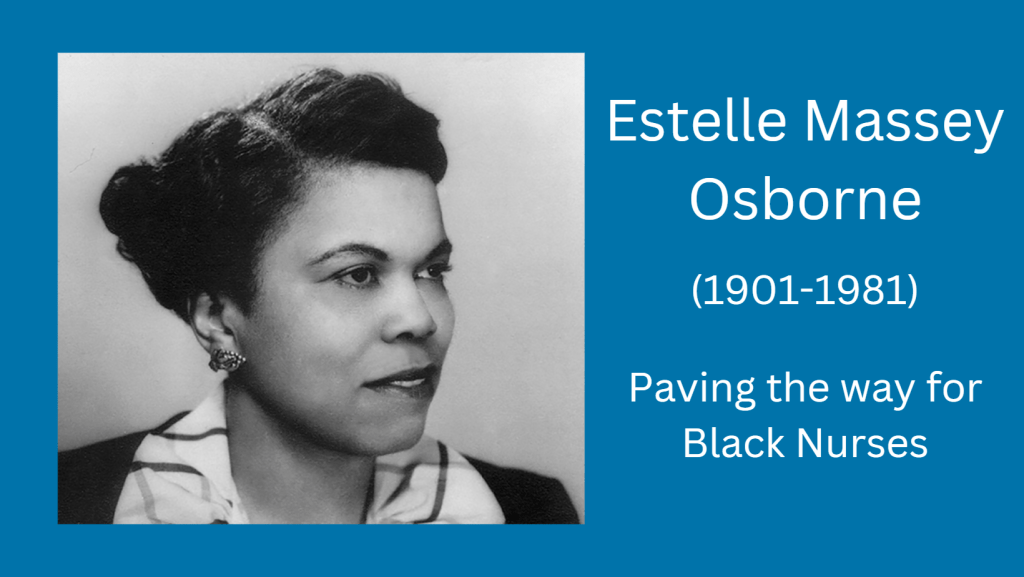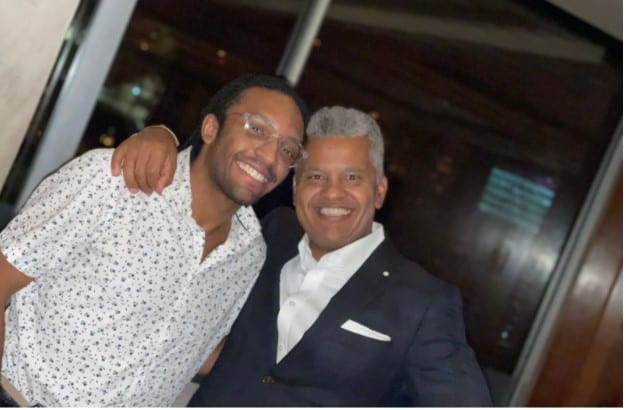
In an effort to remain accountable to communities who have been negatively impacted by past and present medical injustices, the staff at Himmelfarb Library is committed to the work of maintaining an anti-discriminatory practice. We will uplift and highlight diverse stories throughout the year, and not shy away from difficult conversations necessary for health sciences education. To help fulfill this mission, today's blog post celebrates Black History Month by honoring Estelle Massey Osborne, a Black nurse who helped pave the way for Black nurses who followed.
Estelle Massey Osborne, known as “Stelle” to her family, was a hugely influential figure in American Nursing. Osborne was born in 1901 in Palestine, Texas, and was the eighth of William and Betty Massey’s eleven children. After completing two years of teacher training at Prairie View State Normal and Industrial College, Osborne worked as a public school teacher for two years (Schomburg Center for Research in Black Culture [SCRBC], n.d.). Following an act of violence committed at the school that almost resulted in her death, Osborne moved to St. Louis, where her brother Edward was a dentist, to pursue a career in nursing (SCRBC, n.d.).
When Osborne began her nursing studies, only 14 of the 1,300 nursing schools in the country admitted Black students (New York University Rory Meyers College of Nursing [NYU], 2020). During this time, the American Nursing Association (ANA) refused membership to Black nurses and the Navy would not enlist Black nurses (NYU, 2020). By the end of Osborne’s career, thanks to her hard work and dedication to advocacy in the field of nursing, she saw the fruit of her work through the positive changes in all of these organizations.
In 1923, Osborne completed her nursing degree at the Graduate School of Nursing at St. Louis City Hospital, later the Homer G. Phillips Hospital (Encyclopedia.com, n.d.). In 1928, Osborne was the first Black nurse to receive the Julius Rosenwald Fund scholarship (NYU, 2020). She then continued her education and received a Bachelor of Science degree in 1930 and a Master of Arts degree in 1931 from Columbia University Teachers College (SCRBC, n.d.). She was the first Black nurse to earn a Master’s degree (NYU, 2020). Meanwhile, she also spent time teaching at two local nursing schools and was the first African-American instructor at the Harlem Hospital School of Nursing (NYU, 2020).
After completing her Master’s degree, she worked as a researcher for the Rosenwald Fund where she studied rural life in the deep South. Her work focused on investigating ways to improve health education and service to rural Black communities (NYU, 2020). Along with a team of scholars, she helped perform a behavioristic study on the health and welfare of Blacks in the South (Pitts Mosley, 2002). This research experience proved invaluable to Osborne’s later work and provided the exposure she needed to make an impact on professional nursing on a large scale (Pitts Mosley, 2002).
Osborne served as the president of the National Association of Colored Graduate Nurses (NACGN) for five years from 1934 to 1939 (SCRBC, n.d.). The NACGN was “established to promote professionalization, education, and practice opportunities for Black nurses throughout the country” (Pitts Mosley, 2002). In 1940, Osborne became the first Black Superintendent of Nurses at the Homer G. Phillips Hospital in St. Louis (NYU, 2020). The Homer G. Phillips Hospital was the largest exclusively Black, city-operated general hospital in the world and at the time served over 70,000 people (NYU, 2020). Osborne also became the first Black female director of the hospital’s nursing school.
During World War II, Osborne worked as a consultant to the Coordinating Committee of Negro Nursing for the National Council for War Service (NYU, 2020). In 1943, in response to a severe shortage of nurses both at home in the United States and overseas within the military, Congress passed the Bolton Act. The Bolton Act was considered the largest experiment in federally subsidized education in U.S. history and appropriated $160 million dollars of federal funding to 1,125 nursing schools across the country (Frances Payne Bolton School of Nursing [FPBSON], 2023). The Bolton Act also created the U.S. Cadet Nurse Corps which produced more than 124,000 nurse graduates over a five-year period (FPBSON, 2023). Osborne was instrumental in ensuring that Black nurses benefited from the Bolton Act funding in nursing education and financial aid (NYU, 2020).
She was also influential in expanding the number of nursing schools accepting Black students and, with the help of strategic ally Eleanor Roosevelt, in convincing the U.S. Navy to lift its color ban and accept Black nurses in 1945 (NYU, 2020). As a result of Osborne’s influence, the number of schools accepting both Black and White students grew from fourteen to thirty-eight(Pitts Mosley, 2002). The Cadet Nurse Corps had also enlisted 2,000 Black students and was providing financial assistance towards their education (Pitts Mosley, 2002).
In 1946, Osborne became the first Black faculty member at what is now the NYU Rory Meyers College of Nursing (NYU, 2020). During her eight years at NYU, Osborne had the opportunity to mentor numerous Black students and nurses. “Her NYU affiliation also helped to disprove the belief that only White nurses were capable of obtaining and managing leadership positions in nursing” (Pitts Mosley, 2002). Over the next 20 years, Osborne would serve in numerous national leadership positions including as the first African American member of the American Nursing Association Board of Directors (1948-2952), Assistant Director of the National League for Nursing, the first Vice President of the National Council of Negro Women, a member of the National Urban League, and as an honorary member of Chi Eta Phi Sorority and the American Academy of Nursing (NYU, 2020). Osborne was named the NYU Department of Nursing “Nurse of the Year” in 1959 and was inducted into the ANA Hall of Fame in 1984, three years after her death (NYU, 2020).
Estelle Massey Osborne’s impact on the field of nursing and on racial equity within the field is undeniable. Her influence and legacy live on through the long-lasting impact of her work. She did not back down from racial prejudices and worked to dismantle systemic racism within professional nursing. Her work has opened doors for Black nurses for generations to come.
References:
Encyclopedia.com. (n.d.). Osborne, Estelle Massey (1901-1981). Dictionary of women worldwide: 25,000 women through the ages. https://www.encyclopedia.com/women/dictionaries-thesauruses-pictures-and-press-releases/osborne-estelle-massey-1901-1981
Estelle Massey Osborne [photograph]. (n.d.). 30th Annual Estelle Osborne Legacy Celebration. https://nursing.nyu.edu/news/events/30th-annual-estelle-osborne-legacy-celebration
Frances Payne Bolton School of Nursing. (2023). The Bolton Act: Making the nursing profession more accessible to everyone. Case Western Reserve University. https://case.edu/nursing/about/history/bolton-act#:~:text=The%20Bolton%20Act%20of%201943,history%20of%20the%20United%20States
New York University Rory Meyers College of Nursing. (February 18, 2020) Celebrating Estelle Osborne, nurse trailblazer. NYU Rory Meyers College of Nursing. https://nursing.nyu.edu/news/celebrating-estelle-massey-osborne-nurse-trailblazer
Pitts Mosley, M.,O. (2002). Great Black nurses series: Estelle Massey Riddle Osborne. ABNF Journal, 13(5), 114-7. http://proxygw.wrlc.org/login?url=https://www.proquest.com/scholarly-journals/great-black-nurses-series-estelle-massey-riddle/docview/218904485/se-2
Schomburg Center for Research in Black Culture, The New York Public Library. (n.d.). Estelle Massey Osborne papers, 1943-1967. New York Public Library Archives & Manuscripts. https://archives.nypl.org/scm/20749



